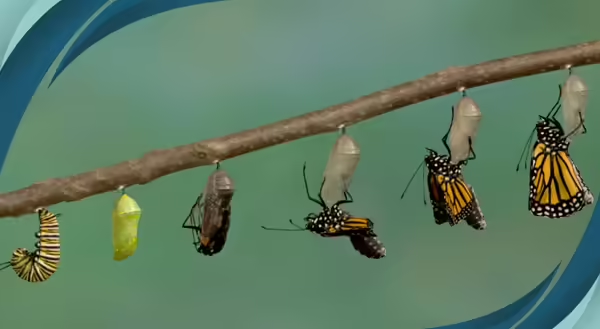
Starting with an egg
Adult monarchs lay their eggs on the leaves of a milkweed plant. In three to four days, the caterpillar will hatch. It will be about one-third the size of a grain of rice. By the time the caterpillar is ready to form its chrysalis, approximately two weeks later, it will have grown up to 10 times the size it was when it hatched. It will shed its skin one more time and underneath will be a light green casing with a ring of gold dots near the top. Inside the chrysalis, the caterpillar’s body will become goo. Over the next two weeks, that goo will form a butterfly. It will hang upside down to dry out and when ready, fly off to start the cycle anew.
Heading south for the winter
Monarchs will go through several generations throughout the summer, going through the cycle of egg, caterpillar, chrysalis, and adult; with each stage (except for the egg) taking about two weeks to complete. However, as the days get shorter, the hot summer sun gives way to cooler evenings, the milkweed starts to fade, and something happens to this final generation. The typical two-week adult lifespan stops, and the butterfly enters a stage called reproductive diapause, meaning this overwintering generation of butterflies will live for approximately six to nine months!
Instead of laying eggs, they begin their journey south. Despite having never been there before. (In fact, it will have been about four to five generations since.) They will join millions of others along a path down through Texas, and into central Mexico. It’s still not well understood how they manage this. This region features oyamel fir forests on steep, south-facing mountains. The fog in this area provides critical moisture for their survival and the low (but not freezing) temperatures help them to survive the winter. They cluster together in the trees, covering the trunks and branches, and wait.
In the spring, it’s time to leave and head back north, beginning the cycle all over again.
Helping out along the way
Lately, monarch numbers have been dwindling and researchers aren’t entirely sure why. Loss of habitat is one possibility, however. In days of yore, common milkweed would grow all over the roadsides and empty fields. Now, those roadsides are mowed for driver safety and many people remove them as “weeds.”
Many species of milkweed (Asclepias sp.) make an attractive addition to home gardens while also giving monarchs a place to lay their eggs. Planting other nectaring favorites, such as blazing star (Liatris sp.), also can bring many species of butterflies to your yard. Fall-blooming asters (Symphyotrichum sp.) are another great choice for butterfly gardens and can be a critical source for fuel on that long journey south.
University of Illinois Extension actively builds and supports monarch butterfly habitats and research. Learn more about one of these initiatives at ipollinate.illinois.edu/.